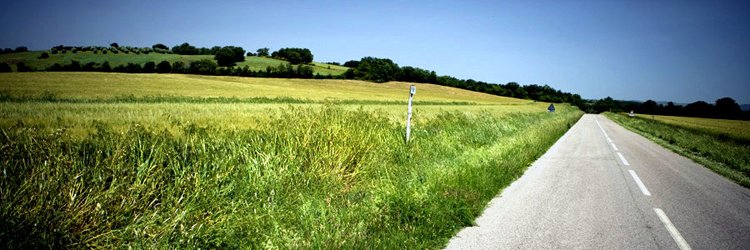I have meant to write a post on the things that might be a “puzzling surprise” for people travelling to Italy for a while, and then this interesting thread on the Slow Travel Forum finally gave me the excuse to sit down and write about it. Actually, it all started with this other thread, where someone reported how she had met some people who had hated Italy because they couldn’t watch basketball and because the bacon at breakfast wasn’t cooked enough. This generated a long series of responses, some got upset, the thread was closed (something that always surprises me, even if it shouldn’t by now… dear God people… can’t you put up with a little criticism!? It must be a cultural thing… in Italy we do say whatever we feel in these situations), but that is beside the point.
I thought it might be nice to comment on a few things that I read, because it’s always useful to get a different perspective on things, so that you know what you can tell your guests before they arrive so that they can be ready for what life in Tuscany (and in most cases, Italy in general) is really like. So here is a list of the most popular disorienting experiences for travelers to Italy.
- Italy is big and there are more things to see and do than most people can conceive of. Tuscany is also big. Seeing the whole country or even only Tuscany in a week, or two or three is simply impossible. There is nothing else to it. To people used to living in large countries where you need 5 hours to drive between two major cities, distances might seem small, but roads are slow, and the density of sites to see even within 30km is huge, and in every major destination (e.g. Florence, Rome, Venice, etc.) there is enough to keep you busy for well over a week. Getting on a tour that take you to 10 cities in 14 days will be tiring, stressful and for many unsatisfactory. My recommendation is to pick a base, and visit the surrounding area, driving for max. 1 hour to reach your destination. Time will fly.
- Food is different from what you are used to, even to Italian food that you find at home. First of all, every part of the country has its own regional specialties and cooking style. Most of the Italian restaurants abroad refer to the culinary tradition of southern Italy. You won’t find spaghetti with meatballs in Tuscany, and probably not anywhere else either; fettuccine alfredo is not an Italian dish at all; pasta is mixed with sauce as soon as it’s taken out of the water and before being served (some will find the sauce is scarce – we don’t overdo it with the condiments); you won’t be served a bowl of olive oil with bread to dunk in it, it’s just not done; you can order everything at the same time, but you will be served according to the standard order of Italian courses (antipasti, primi, secondi and contorni, dessert, coffee); salad is not an antipasto but a side dish we eat with secondi and soup is not an antipasto but a first course that substitutes a pasta dish; you don’t have to eat a full 4 course meal every time: it’s perfectly normal to order simply one or two courses; in most places you will be charged between 1 and 4 euros called “pane e coperto“ (bread and tableware) but it is actually a service charge and it has nothing to do with bread; water is not free of charge; cappuccino is not normally served after a meal (it’s a meal on its own and it is usually breakfast food) but in more touristy places they are used to tourists ordering it after lunch; pizza will be thinner than what you are used to, and it does not come with chicken, corn or pineapple on top; in most places you won’t be served lunch before 12.30pm or dinner before 7.30 pm; the table is yours for the night so don’t expect somebody to come check on you every 10 minutes, to see how you’re doing or to bring the bill unless you asked because it’s just not done: waiters don’t want to disturb customers while they are eating and a little pause between courses in considered polite; you can share food, just ask for a second plate; in most restaurants you won’t find an English menu; if you see pictures of what you are about to eat, run away: it says frozen food; unless it’s specified on the menu, ingredients will be fresh and not frozen; you won’t find food that is not in season: neither in restaurants nor in supermarkets; kind of sadly, you won’t also find much variety in terms of regional cooking (in Tuscany you will find mostly Tuscan food) or ethnic food (only in larger cities will you find Chinese restaurants, kebab and maybe Indian or Mexican food); bacon is, alas, impossible to find, so are cheddar cheese, bagels, cheesecake, meat pies, salad dressings other than olive oil and vinegar, white vinegar and chicken wings; doggie bags don’t exist (taking leftovers home is considered very rude); many restaurants now accept dogs (ask before you go): if they have outdoor tables there is no need to even ask.
UPDATE FROM THE COMMENTS
When ordering an entrée (secondo) it doesn’t automatically come with side dishes. When you ask for a steak, you don’t get your “choice of fries, salad, baked potato or rice”. If you want fries or a salad (never rice) you have to order it separately, it comes on a separate plate, and it shows up as a separate item on the bill. Depending on the restaurant, your side dish may not even arrive at the same time as your entrée. Better restaurants will strive to time everything so that all the dishes of everyone at the table are ready at about the same time, but many others where they just don’t stick to that rule. If a dish is hot and ready, send it out, whether or not the fries are done yet. Better to get the fries later than to leave the steak under a heat lamp for five minutes.
NEW UPDATE FROM THE COMMENTS
If you ask for pizza perpperoni, you will get pizza with bell peppers. If what you are after is pizza with spicey cured meats, that’s what you have to ask for: pizza al salamino piccante. - Not all bars charge extra to bring your coffee to the table, only the ones in the most touristy spots. It is perfectly acceptable to get your coffee at the bar and then sit down and it costs the same in most places. Some places ask for you to pay before you order.
- Getting around can be a challenge. Driving is much simpler than people say: do your own thing and ignore what other people are doing. People do not respect safety distances between vehicles, so expect to have someone stuck to your bumper; in no case though is it acceptable to pass on the right, not even on the few three lane highways; road numbers marked on maps mean nothing most of the time: roads are rarely marked with the highway number but instead have signs indicating the name of destinations in the directions you want to head; most of the time street names are not marked, and when they are it’s often on plaques on buildings: be prepared to ask; even numbers are on one side of the street and odd numbers on the other; some cities like Florence have a double numbering system: numbers in one color are residential numbers and in another are commercial number so you can have the same civic number twice on the same street, once for a private residence and once for a store; most city centers are closed to non-residential traffic: you will be fined if you drive past the cameras at the entrance of the ZTL (Limited Traffic Zones) and they are marked, you have to know what to look for; ZTLs are not a scam to squeeze more money out of tourists: they are a fundamental survival tool for residents of city centers and fines are given out to local and foreign drivers alike; if you are from a non-EU country road signs are different: make sure you learn them before driving in Italy; there won’t be any signs in English: neither on the road nor in most minor train and bus stations; taxi service outside the major cities does not exist and if you get a cab to take you to your hotel 30km outside the city it will be very very expensive; cabs have fixed fares between major landmarks (e.g. from the airport to the train station): ask before getting in the cab what the fare is and make sure you are on a licensed cab (they must have their license number clearly marked on the car); rural areas are not well served by public transportation: if you want to be in the countryside you need to rent a car or be miserable; expect to be stopped by cops for a random check: it means nothing, they just have to do it. Bus and train tickets need to be purchased before boarding: you can buy bus tickets at any tobacconist’s. You need to validate tickets: there are yellow machines on the platforms in train stations and validating machines on the buses themselves. If you don’t you will be fined.
- Most shops and churches will be closed between lunchtime and 4pm: people go home for lunch; most shops will also be closed on Monday morning, or on Wednesday afternoon (groceries).
- Information you find in guidebooks and even on the doors of shops and museums may not be valid anymore: it takes forever for people to update their schedules, even if they have in fact changed. In general everything is open between 9am and 12.30pm and 4pm and 7.30pm.
- We use the metric system: distances are in meters & kilometers, weight is in kilos and grams. Don’t expect people to have any clue when you use miles or pounds: they won’t. Also, gas is measured in liters and not gallons. Temperatures are in Celsius degrees.
- Drinking fountains and public restrooms are very rare. What locals do is to go to a bar, buy a little something (a coffee, a packet of chewing gums, a bottle of water) and ask to use the restroom. Alternatively most large stores like Coin, Upim, Standa etc. and shopping malls will have public bathrooms, so will train stations (you might need a few coins to get in, so always keep some 50 cent and 1 euro coins on you). Take advantage of restrooms in restaurants and museums. Most public restrooms will not be as clean as those you might be used at home (but they will have full doors and walls…): toilet paper is a luxury, always keep a packet of Kleenex in your pocket. Some tourists are horrified by “bagno alla turca”, which is essentially a hole in the ground. They are quickly disappearing: I can’t remember the last time I saw one in Tuscany. The new laws require for any public place to have a restroom that disabled clients can also use, and it is certainly not the case of a hole in the ground.
- Some places might be dirtier than others: graffiti is unfortunately a common thing in some cities and so is dog poop and litter on the sidewalks. Controls are becoming stricter, so cities are becoming cleaner. If you travel with your dog, you need to have a little bag with you.
- You need to have some form of identification on you at all times: if authorities ask to see your documents you need to show them; if the hotel asks for your passport details it’s not because they want to steal your identity… we are required by law to communicate to the local authorities the personal details of any guests we have.
- Don’t expect everybody to speak English. Most people don’t.
- If you rent a place, you should be aware that usually showers (and bathrooms) are smaller in size that what you are used to and water pressure is low. Standard bed sizes are 160cm x 200cm for a double bed and 80cm x 200cm for a single bed. There are other less common sizes now too, but these are the standard “matrimoniale” and “singolo”. Some hotels will have two single beds pushed together instead of one large mattress. Washing machines take forever to complete a cycle (up to two hours) and driers are very uncommon: we hang our laundry outside. Older buildings won’t have powerful electrical systems, so if you plug more than one appliance at the time the circuit breaker might trip: remember to ask the rental owner where it is and how you restore power. Voltage is 220, and there are several types of plugs. Make sure you have a travel adaptor for your appliances and that they can actually be used in Italy.
- The customer is not always right and having to wait to be served is normal. If the shop assistant believes you are wrong you will get a piece of his or her mind. Annoying but that’s how it is. Returning things because you have changed your mind might be your right, in theory, but in practice most people won’t give back your money. Most will offer store credit instead. Credit cards are widely accepted but some smaller places won’t take them. Bars usually don’t take credit cards.
- People skip the line all the time. It’s infuriating for the locals as well (I hate it) but expect the occasional older lady just to get in front of you because she is older, or a group of kids to get in front of you at the train station or to get on the bus. We are not good at queuing and you might end up seeing some good fights. LOL
- Time is an approximation… (I am very guilty of this). If an Italian gives you an appointment for 3pm expect him/her to show up any time between 3 and 3.15 pm. 15 minutes late is still on time!
- We usually don’t tip. Tipping is becoming more and more common in restaurants, but usually we never leave more than 2 to 5 euros, no matter what the total is. We rarely tip in bars (I never ever do), taxis, hotels, shops. Taxes are included in the prices you see on the shelf, so that’s what you will pay at the cash.
- If you are lucky enough to mix and mingle with the locals and to be able to participate in some discussion, don’t be afraid to speak your mind. We are used to saying what we think about anything. The concept of politically correct is is an alien concept and the idea of privacy is completely different here. We tend to get personal, we talk freely about religion, politics, social issues and personal beliefs. We speak in a loud voice and often interrupt each other: it might not be polite, but listening in silence until the other person has finished is something you see rarely and some people say they feel uncomfortable not getting any feedback when they talk (that would be me too). Waiting time between turns of speech is short: if you want to say something jump right in. Also we tend to rephrase the same concept over and over even if we have already stated a fact: it’s just a rhetoric thing… we don’t assume you are dumb!
- Banter and irony are common: don’t get upset, it’s our way to make friends.
- We dress according to the season, not the weather. Feel free to wear what you want, but don’t get upset if people look at you with a funny face if you wear a tank top in April. Most people will still have their coats on even if it is 20°C outside, stupid but so.
- It is not normal, and I would like to underline, NOT, if men comment on you when you walk by, whistle, pinch your butt, call you names, or whatever, not matter what ridiculous romantic comedies want to make you believe. Do not expect or accept to be treated with less respect than you would at home. Sane Italian men will look at you (eyes are for looking at beautiful things) but they will keep to themselves: avoid those who don’t and that will keep you out of trouble. Do not use any less judgment than you would if you were back home: weirdos are everywhere, but there is no way that is normal, acceptable behaviour in Italy, not unless you are visiting an underdeveloped area which is stuck in the 50’s and even there, there is some respect to be taught.
- UPDATE FROM THE COMMENTS: Italian homes are kept cooler in the winter and warmer in the summer than what you are used to. If you’re here in the summer, be prepared for the heat. If you’re coming in the colder months, bring extra sweaters and expect to wear them all the time. Energy prices are much higher here and it costs a lot to run the air conditioner all day, or to heat the house enough so that you can walk around indoors in a t-shirt and shorts in the winter. Many places keep heating or air conditioning charges separate from the room charge for just that reason. Make sure that you know whether heating or air conditioning is included in the price and if not how they plan to charge for it. Some places charge a fixed rate per day, others read the meter at check-in and check-out which can result in some very nasty surprises if you’ve had the temperature set to icebox/sauna all week.
- UPDATE FROM THE COMMENTS: Tap water is safe to drink everywhere in Italy. This is not Mexico, nor India. Drinking a glass of tap water will not result in you spending the rest of your vacation in the bathroom.
Anything else that you think I should add? Suggestions are very welcome!
Have fun on your next trip to Italy!











This is a brilliant summary, well done! Behind every remark you make I can hear the echoes of perplexed questions from foreign visitors.
This is excellent Gloria! Having recently spent a week in Tuscany I can identify with all that you have said. A week was definitely not long enough – we saw loads but still so much to see. The driving was rather scary at times – we decided that Italian drivers must believe that they are saving fuel if they drive in someone else’s slipstream!! I did smile when I read the bit about ‘doggy bags’. The waitress in La Merlaie in Civitella offered me a box for my leftover pizza, (didn’t realise how big it would be) – I would never have dared to ask for it myself 🙂
Hi Katy, pizza is maybe the only case where it is acceptable to take leftovers home (if the waiter offers). Thanks for your comment!
Penny thank you for stopping by!
Excellent, Gloria. Brava.
Here are a couple more to add under point #2:
When ordering an entrée (secondo) it doesn’t automatically come with side dishes. When you ask for a steak, you don’t get your “choice of fries, salad, baked potato or rice”. If you want fries or a salad (never rice) you have to order it separately, it comes on a separate plate, and it shows up as a separate item on the bill.
Depending on the restaurant, your side dish may not even arrive at the same time as your entrée. Better restaurants will strive to time everything so that all the dishes of everyone at the table are ready at about the same time, but I’ve eaten at (and worked at) many others where they just don’t stick to that rule. If a dish is hot and ready, send it out, whether or not the fries are done yet. Better to get the fries later than to leave the steak under a heat lamp for five minutes.
Wonderful, synthetic breakdown of what to expect as well as what not to expect. Very well done! Thanks!
Fabulous post Gloria!
Thank you Kate and Donna!
Thank you so much for this article. Everyone needs to
read information such as this before they travel abroad.
Great post! I can definitely agree with #2. It took me up to 1 1/2 years to finally find cheddar cheese! However, I still can’t buy it from the store, but luckily a little Mexican fast food joint in a shopping center sells it to me by the kilo (15 euros…expensive!!!). However, alas I can make enchiladas!
This is a fantastic summary, Should be essential reading. If only I’d known all this before moving to Tuscany I would have saved myself an awful lot of time spent figuring all this out! It’s how much n.14 bugs me that makes me realise how very British I am!
Grande Gloria!
I’ll add a supplement: With the exception of an occasional gelato, we don’t walk and eat or drive and eat. Vero? 😉
Thank you all for stopping by! Nan, absolutely! Eating is a social activity that takes some time! LOL
Great post. It made me laugh when talking about the no meatballs and spaghetti. My son and I traveled with my dad (in his 70s) a couple of years ago to the region and every, and I mean every restaurant, we went into he want to find spaghetti with meatballs…and would you believe we actually found a restaurant tucked away in Venice that we went to eat on our last night in Italy that the only reason we went there was that we found it had spaghetti and meatballs 🙂 One of the best trips ever. Can’t wait to go back soon.
Gloria, I’m going to save this essential reading and give it to all our overseas guests before they arrive!
I already give a very detailed account on what to do at Roma Termini! The trouble we’ve had…..*sigh*!!
Absolutely spot on! FAB!
PS – @Nan – the only people I EVER see driving and eating (and being on their mobiles at the same time – so no hands on the wheel) are articulated truck drivers. You can tell the ones that do it, they are the ones weaving all over the road!!
Hi Michelle and Giselle! Thank you for your comments! So you did find spaghetti and meatballs! Actually when I say that the dish doesn’t exist I am not telling the whole truth. Not sure about the Venetian culinary tradition, we should ask Monica Cesarato, but in Southern Italy they do cook meatballs in tomato sauce, but then they take the meatballs out of the sauce, use the sauce on pasta and meatballs as a second course. I lived with a girl from Apulia when I was in university and she used to do that all the time. It was her version of ragù. However I have never seen her eat pasta and meatballs at the same time. I guess the north American tradition comes from there but it has been reinterpreted to make the most of the dinner time! LOL
I cook spaghetti, I cook meatballs, but not the two together. i think it is a recipe which was imported in USA from the South. Definetely not a Venetian recipe, believe me, also because up here we do not eat spaghetti, but bigoli!
(now we eat spaghetti because it is cheaper, but traditionally we used to eat bigoli and generally with fish, not with meatballs)
cisao ciao
Thanks for chiming in Monica!
When i was in Italy, it became apparent to me that road signs that denote ‘stop’ or ‘no parking’, in fact most signs, are merely suggestions; hardly anyone obeys them!
That’s right. Not so much the stop sign, but the no parking sign often is just a suggestion… But fines are frequent!
Brava! If you don’t mind, we will share this with our future guests too, as almost everything you have listed, has been encountered by our guests at one time or another.
Another aspect on driving, is the Italian fondness of tunnelling through hills, rather than going around them and in addition to being tailgated continually, there seems to be the universal rule of increasing the speed by 10 or 20km ph when entering a tunnel. Presumably the logic is to get out faster, but it can be very intimidating when you have an articulated lorry doing 100+ 10 feet from your bumper.
At big wedding bashes in Abruzzo, the meals are so big that it is customary to take leftovers home, no problem. From what I know, meatballs were “invented” in New York city, during the first waves of immigration from Italy. it was a way to make a healthy meal with leftover bread and just a bit of meat to get some protein in the meal. In southern Italy, cheese balls in tomato sauce are very popular, but they are never served with pasta. Our pizzerias in Abruzzo do serve pizza with corn and other unexpected ingredients. Yumm! BTW, great article! Will share!
Can I just copy and paste it and send it to all my arriving foreing guests??? Will save me so much talking-discussing- etc!!!
Thank you for your comments Sergio and Pia. That is the beauty of Italy: you move 200km and everything changes. I know that in many southern regions taking food home after a wedding is done. Here in Tuscany it is a no no. Monica, feel free to cut and paste! 🙂
You go girl.
Add to #19: Flip flops and shorts are for when you see seagulls, not in the city.
Well said Alexandra! LOL
VERY well written! I so can relate to almost everything on your list as I’ve heard it all from traveling tourists complaining that things are so different in Italy than they are back “home”.
We traveled down one coast of Italy and up the other in 1987 and my 13 year old daughter was beside herself when we couldn’t find a “regular” toilet south of Rome on the autostrada. 13 year old girls do not pee in holes on the floor!
We also did meet some very rude Italian men but it was just in one small town in the hills of Calabria, and it WAS 1987. In all the years I’ve traveled around Italy since, I’ve never had that experience anywhere else.
I am going to post a link to this blog post both on our farmhouse rental site as well as my Umbrian Travel one.
THANKS!
I loved each and every one of your thoughts. I laughed my way through them. I’ve also found that the “lanes” painted on roads have little or no meaning. If there are 3 lanes painted on the roadway, but 4 cars and a motorcycle fit side by side, then 4 cars and one motorcycle will be side by side. I love, love, love the fact that everyone on highways passes only on the left and slower drivers always stay right. Thanks so much for this post.
Thank you Deborah and Rosann!
Another thing that I forgot to add but that Rebecca of the Brigolante Guest Apartments (http://www.brigolante.com) pointed out is the difference in “climatisation”. Italian homes are never very cold in the summer. Actually air-conditioning is becoming more popular now, but it still not very common. And in winter, houses are never warm enough that you can be in short sleeves. By law we couldn’t have more than 19°C indoors for energy saving reasons, so we keep warm with clothes. Don’t expect a super cool or a super warm room/house. If you visit in the summer be prepared to sweat a bit, and if you come in winter, make sure you have warm pijamas.
Another good suggestion by Jan on the Slow Talk Forum:
“You can’t just hail a cab.
Taxis are available at designated taxi stands.”
Of course only in the cities. Outside of the city, no taxi service.
i love this artcle especially #2–I STUDIED AT THE U O BOLOGNA AND LOVE ITALIAN FOOD. I HAVE BEEN PREACHING TO MY AMERICAN FREINDS THAT THE ITALIAN FOOD EATEN IN MOST ITALIAN REST. IN THE STATES YOU WILL NOT FIND IN ITALY–THANKS FOR WRITING THIS BLOG
Excellent article, Gloria! Although I have to disagree about the stores closing between lunchtime and 4pm. In small towns, yes, but rarely in the larger cities have I seen this and not in the more touristy areas.
Hi Deborah, it’s true, it’s more and more common for larger stores (usually the chain stores – COIN, Upim, Standa, etc) to keep more international hours (usually 9am – 8pm), bit most of the regular stores (usually family owned) still close. At least in the cities that I happen to see more often (Pisa, Siena, Grosseto). Rome and Milan could be a different story of course.
Baci!
Here’s one more for the list:
Tap water is safe to drink everywhere in Italy. This is not Mexico, nor India. Drinking a glass of tap water will not result in you spending the rest of your vacation in the bathroom.
That being said, in many parts of the country the tap water tastes awful so people usually drink only bottled water. In Pisa, for example, the water is so hard that I’d hate to think what my kidneys would look like after drinking it for the better part of my life. In Civitella, our tap water comes from a source up on Monte Amiata and it’s better than the bottled stuff.
As I pointed out a couple of days ago on the Slow travel Forum, I recommend you to avoid putting feet, with or without shoes, on chairs, sofas and tables (e.g. low tea tables). In addition, please keep your shoes on in public as well as in private houses.
Italians are very particular about feet as shoes pick up all sort of dirt so it’s felt they should be firmly planted on the floor!
Another comment regarding shoes: one habit I know a number of households in (mostly) northern Italy use when you visit is to have you take your shoes off near the door, at which point they provide you with house-slippers which are present in a variety of sizes just for guests.
And thick cut pancetta, if you find the right variety (only one butcher near me has the kind I like and “works” as bacon) works just fine as a substitute.
love this heads up
why do people travel if they want things the way they are “back home”
never ceases to amaze me
That is some excellent info, Gloria !
I agree with 99% of it, but will share some of my experience. I was in Italy for 2 weeks in 1993, then several days each in 2006 and 2010:
— I never had a problem finding someone who spoke at least some English, especially the younger people… Even when they didn’t, they seemed to understand what I asked. Hint: take a pen and small notebook. If you write your words down (keep it simple), they may recognize the similarity between, say an English word and the Italian. That seems to alleviate the foreign accent problem…For directions, pointing to a map and asking or writing (example: “via Aurellia ??”) can help…
— You’re right about the clothes washers (long cycle time) and lack of dryers. But I noticed there are some coin laundrys around…
I found one a street away when I stayed at hotel in Tirrenia in 2006, and one a block from your Behind the Tower apartment. So my last day in 2010, I just took my clothes there to dry them, just for the time sake. (You might want to tell future customers about it; its on the right side of the road as you walk toward the Tower:). Both visits there was no one else in the laundry…
— About the train and bus tickets (validation). In 1993 and 2006, I never knew about getting my ticket stamped (validated). In ’93, the ticket man always asked me if I was Italian when he came through and I said “no” and showed my passport. He wrote something on the back of my ticket(probably “another dumb tourist” !) and went on by to the next traveler….Same thing happened in 2006, but a young lady sitting across from me explained in passable English about getting it stamped. Funny thing, but I never saw the stamping machines in either visit…???…Anyway, I’m not sure how lenient the busses are, but I was NEVER been fined on a train. Of course, I did buy my ticket each time….(PS – I had a car in 2010; didn’t use the train or bus)
— About dogs: In the USA, most people don’t care if you pet their dog while they’re walking by – I mean, like in a park or walking trail – and I rarely see a mean one that way. But in Italy, I never saw a “friendly” one. Maybe a bit protective of their owners?? Or just a ‘city dog’ thing? Point is, for American visitors, please use caution! Just sayin’ …
Ok, those are my pointers 🙂 –robb
It’s true that more and more people can at least understand some English. Speaking it is all a different story. You also happened to be in the area of one of the major universities, so most young people will have a degree of some kind, hence they will have studied some English. Besides, Pisa is so popular with tourists that everybody had to learn some English anyway.
Mention of the laundry place should be in the file we leave, but I will double check. Most Italians will avoid it, because we don’t like to wash our clothes where people we don’t know wash theirs. Just habit I guess.
As for validating machines they are everywhere in the station. Usually tickets on trains are controlled regularly, whereas it’s rare to be asked for your ticket on a bus.
Dogs: you haven’t met my dog! She’s a cutie. But she’s also a retriever. Small mutts tend to be more aggressive. As a rule of thumb though, always better not to touch dogs you don’t know…
By the way Gloria, tell me what you think of this site – some tips about ordering food in Italy. Accurate or not?
http://www.italylogue.com/food-drink/menu-tips-to-help-you-order-in-restaurants-in-italy.html
Grazie!
Very accurate! Jessica, the author, is an excellent source of information for Italy. She is one of the members of our Italy Blogging Roundtable too.
Excellent summary. I would just add that if you plan to drive in Italy and don’t have an EU license, you have to get an IDP, which has to be shown along with your regular license if you’re stopped by the police.
Thank you! I should add that to this other post as well: To drive or not to drive in Tuscany? That is the question..
Ciao Gloria,
My husband and I are Brazilian and went to Italy last September. Couldn’t agree more with this post of yours. Things are EXACTLY how you describe them.
Funny thing though is the similarity between you and us! Sao Paulo (where I live) was strongly influenced by the Italian immigration and many things are just alike, from the way people discuss matters (interrupting each other) to the way we’re served by waiters, including being ok with a 15-minute delay!!
We felt at home, really.
Bacci,
Thank you for your comment Fernanda!
Excellent post Gloria!
I’ll be passing it along to travelers–it’ll save a lot of explaining!
Thank you Susan! In you have anything to add, please do!
I love this blog and especially this article you posted. I am going to travel to Italy this July for a wedding. Would recommend all my Asian friends coming to the wedding to read this first! Very informative and thanks for sharing!
Excellent info, thanks. We read it while siting in a restaurant and were much more polite customers by the end.
Recommend you add discussion about how to weigh and bag your own produce in the markets. We saw this in Spain too, but not in other countries.
Good point! I will add it!
Thank you for sharing this. It’s very helpful esp to people like me. And also for being honest.
More power.
Hi Again New Friend!
I could so relate to all that you have written! I learned everything you wrote about on my first ARitsT trip to Tuscany and more about 2 yrs ago!
Thank you for adding even more valuable info.
Could you Touch on “Ice” Ice Cubes (or lack of) in Italy??
and No Washcloths, and Your Day 1 Hotel/Villa Towel…needs to be hung and dried because that’s it for the week!
Fondly, Therese
Thank you for your suggestions!
Excellent! Lots of outstanding insights, especially point 20: “Do not expect or accept to be treated with less respect than you would at home.”
My only quibble would be with Number 17: “Speak your mind, when you are talking to Italians”. Yes, within reason. As anywhere, as long as your comments are not negative, you can say anything you like. No-one, in Italy or anyplace else, likes the new-arrival — and that can mean anyone who has lived in the country for less than 10 years or so — to be telling the locals what they should do.
I didn’t mean it like that. I meant it in the sense that we have no problem hearing about other people’s political, religious and moral ideas. Even if different from ours.
Gloria! You have covered a lot of ground regarding some do’s and Don’ts while traveling in Italia. Allow me to put in my two cents regarding traveling, eating, driving, and communicating in la Bella lingua. First, I find no fault with anything you recommend and observe. Having travelled Italy over ten weeks as a “tourist” mostly and also as un studente della lingua my wife and I have relished our time among gli Italiani. Just a couple of observations. As an octogenarian I still tell the story about being moved to the head of the line in Rome while waiting to visit the Forum by an attendant who traveled the long waiting line and enquired if we were over sixty five! Not befor nor since have we been treated with such deference, not that we we looking for it. Driving in Italy, Tuscany in particular was enjoyable. One needs to drive aggressively but not with abandon. Regarding food, I have found you can eat “Italian American” if you eat in places frequented by tourists. They cater to them and their tastes. One must seek out local trattorias and restaurants for good Italian food. We often would ask the cameriere to help us select our dinner. Tuscany is special of course and I have some Tuscan blood thanks to my bisnonna. Was there last in the spring of 2008 for two weeks staying at an agrituismo outside of Pienza. Bellisima! One last funny story. Americans aren’t the only ones with made up specialties. While dining in Liguria, Pesto country, the menu listed something called American Pizza, pizza with French fries on top. A new one on me!